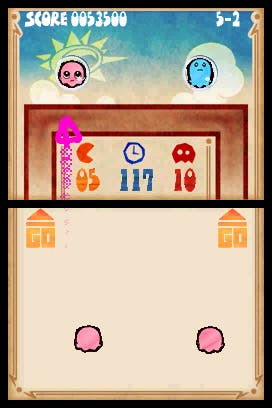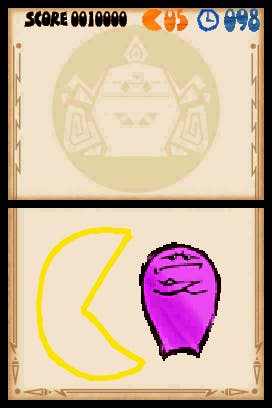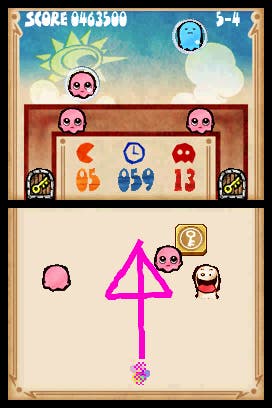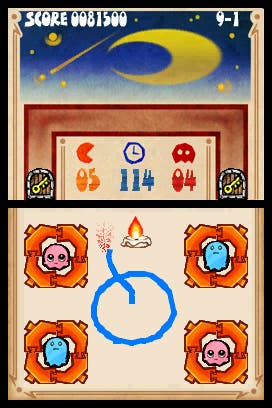Pac-Pix
Ghostbustin' comes of age.
It's certainly hard to fault the DS's early software line-up for its endearing originality, but the harsh question we always have to ask each and every one is would you really want to shell out full price for it? Games like Pac-Pix fall perfectly into this troublesome category, for as much as games like this delight us with their freshness, originality and immediacy, if someone from Namco came around shaking a Pac-Man hat at us asking us for a contribution, we'd probably pat our pockets, avoid eye contact and whistle nervously.
But as an exercise in showing off a cute way to utilise the touch screen, Pac-Pix is absolutely ace for the first few hours. Who could fail to fall in love with a game that involves drawing your own Pac-Man to chomp on an array of ghosts? It's pure gaming right from the off, and marrying the first game we fell in love with to the chunky, pocket-stretching DS seemed like a mighty fine idea to us. It's the kind of game you'd feel happy to take home to your parents to show off the kind of game anyone could play, but would we pay money for it? No. Not the sort of money Namco/Nintendo are asking for it. Not for a minute. It's a lovely tech demo - as endearing as they come - but you'll be tiring of the novelty within the first day in its company.
I aint 'fraid o' no ghost
It all starts off so promisingly, too. Namco, typically, has managed to shoehorn a lovably bonkers storyline into the equation, involving a demented wizard who's able to create terrifying spooks just by drawing them with his 'Ghost Ink'. For reasons best known to themselves, these crazy ghosts begin jumping into books and pictures and generally causing the kind of havoc that Pac-Man was invented to put a stop to.
Somewhere along the line, our hungry yellow-bellied hero has acquired a magic pen (um, how does he hold it?) and has defeated them with his weapon (oi, stop sniggering at the back) by locking them into a book. But, as if the story couldn't get any more inexplicable, Pac-Man gets captured within a piece of paper with the nasty Wizard - and now it's up to you to grasp the magic pen and take over Pac-Man's movements and gobble up all these nefarious ghouls. We knew there'd be a logical explanation for it all...
So, to summarise, draw Pac-Man onto the DS' touch screen, eat ghosts, win game. Okay, so it's not quite that simple, but the quarter-century-old chomping concept that's served Namco so well is still going strong after all these years. Pill popping has been ditched from the mix, though, and Pac-Pix instead focuses on clearing a set number of ghosts from each 'page' of the 12 chapters in the 'book'.
Wakka wakka wakka

As easy as it might initially seem, the touch screen only recognises one particular way of drawing a Pac-Man. Starting from the underside of Pac's top 'lip', you have to draw the V of his mouth before connecting the 'C' part back to where you started. Try it any other way and the squiggles that remain on the screen are ignored and quickly disappear - however lovingly crafted it might be. But given the level of repetition involved in drawing your creation, it becomes second nature in a matter of seconds.
After that you've simply got to guide your clumsily-penned Pac-Man around the two screens as best you can, eating up all the ghosts without letting him fall off the borders of the screen or get bounced into oblivion by the increasing number of obstacles that crop up along the way. The rules are simple, though, and serve you well for the entire game; drawing straight lines directly in front of the direction Pac is facing enables you to alter his direction. For example, if Pac hits a downward vertical line that you've drawn in front of him, he'll head in that direction, and if the then hits a horizontal line that you've drawn from right to left he'll go left when he hits it. And so on.
Keeping your Pac-Men on the screen is all-important (you can have up to three of your creations chomping around at any one time) as if you let them drift off you'll lose one of his stock of (five) lives, but it's easier said than done as you'll discover once the action gets a mite more frantic. The smaller you draw your Pac-Men, the faster they more move and hence can catch the more slippery ghosts more effectively. On the other hand, it's crucial to keep a track of where they're heading before they vanish for good, while the fat lumbering Pac-Men can devour everything in their path. It's a good balancing act you'll learn to juggle as you go through.
Greedy guts

Meanwhile, the main play area on the touch-screen links to a tunnel on the upper left and right of the upper screen. Sometimes it requires unlocking first by running over a timed pad with your yellow blob, but one thing you don't have to worry about is how big or small your Pac-Man is. Regardless of how improbable it looks, you can squeeze even the biggest Fat-Pac into the smallest hole and he'll continue his journey up through the tunnel, along and down, before reappearing at the other side. Along the way you'll collect stray ghosts, bonus fruit, extra lives and other goodies along the way, while also giving yourself precious breathing space to draw other Pac-Men or even shoot arrows up the screen to retrieve the ghosties trapped in bubbles above the tunnel.
As seems appropriate for a game set in a book, each level is a 'page' and each 'chapter' consists of around five or so pages. Every so often the climax will involve a face-off with an increasingly bizarre boss, be it a purple Monster Munch that muscles his way around, or a multi-eyed Toad freak that rains death on your parade from up above. Initially it can be a bit confusing to be bounced off a larger boss, only to realise the solution is as simple as drawing a bigger Pac-Man, but the solutions are logical and the game is tightly designed. It quickly develops into one of those 'one more go' games, and feels addictive thanks to a gentle learning curve that soon builds to a satisfying challenge.
A few hours in you'll have easily cleared the bulk of what the game has to offer, but it soon ratchets up the challenge to the point where the game can get very tricky indeed. Creatures will begin to hide up in the top screen, and at that point you gain the added ability to fire arrows up at them to knock them down into the lower screen, and later on you get to draw bombs as well. Being able to draw these quickly and accurately becomes every bit as important as begin quick on the draw with your Pac-Men, especially give that you're against the clock the whole time. Add to that other challenges like little cretins that squirt ink down from above and numbered sequences that task you with chomping them in order, and it's a game that tests your resolve very well indeed.
Quick off the draw

Once you get locked in the groove of frantic drawing and wafer-thin failure the game starts to become a hugely challenging affair, but also a lot less fun into the bargain. Tempers fray, patience wears thin and the novelty factor begins to wane as you acknowledge that the DS's touch-screen input isn't really up to the task of very fast, precise input. Being knocked right back to the beginning of a particularly challenging chapter also begins to wear you down. Add to that the fact that the game's not very big, and that the action is ultimately very repetitive, and you're left with the sort of game you're glad to have tried but probably not all that happy to have spent top dollar for.
The graphic whores among you will also not be hugely impressed with what is, after all, the most basic looking DS title around. Admittedly, this is down to the game design more than anything, but with sparse backgrounds, tiny character graphics with minimal animation and your wobbly Pac-Man to look at, it's not going to win awards in that department. It does have its own unique charm, though, and it's unfair to rail too much against it.
Sonically it's a typically burbling effort that's sure to craze anyone in earshot, consisting of a bunch of Pac-Man refrains remixed for old time's sake. But after the initial wave of nostalgia you're reaching for the volume slider to maintain your sanity.
Chuffed

Aside from the fairly short-lived main game, there are a bunch of pretty pointless Easter Eggs to suss out, but nothing that's going to affect whether you'll want to buy it or not. As we discovered in our import preview a while back, you can draw a few amusing gestures in the Sketch Book mode, such as a farting bottom, butterflies, rain clouds, snakes, and so on. All good fun - but fun for approximately three minutes and never returned to. Ah well.
Pac-Pix was always going to struggle to be more than a cute little concept game that showed off how cool the touch-screen idea was, and so it has proved. For a few hours it's a really entertaining diversion that's unlike anything we've seen before. On the basis of originality and freshness alone it's worth top marks, but the problem that almost everyone has had with the game is that, like many novelties, it soon wears off. If you can track Pac-Pix down for a low price then it's worth checking out if you're looking for a completely unique handheld gaming experience, but otherwise we'd suggest checking out some of the other far better DS titles with superior longevity. Nice try Namco, but next time we'd like a tad more variety, thanks.

